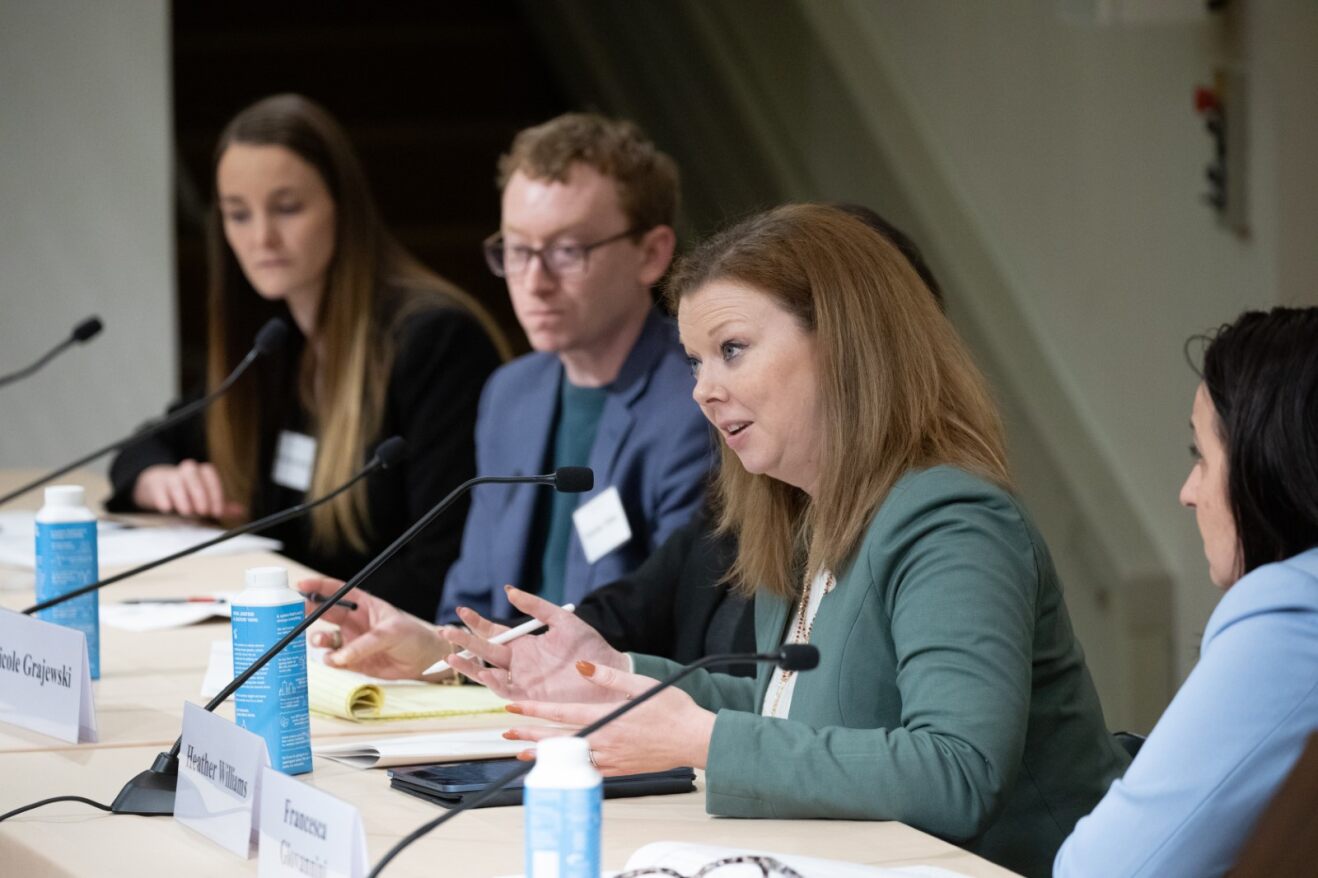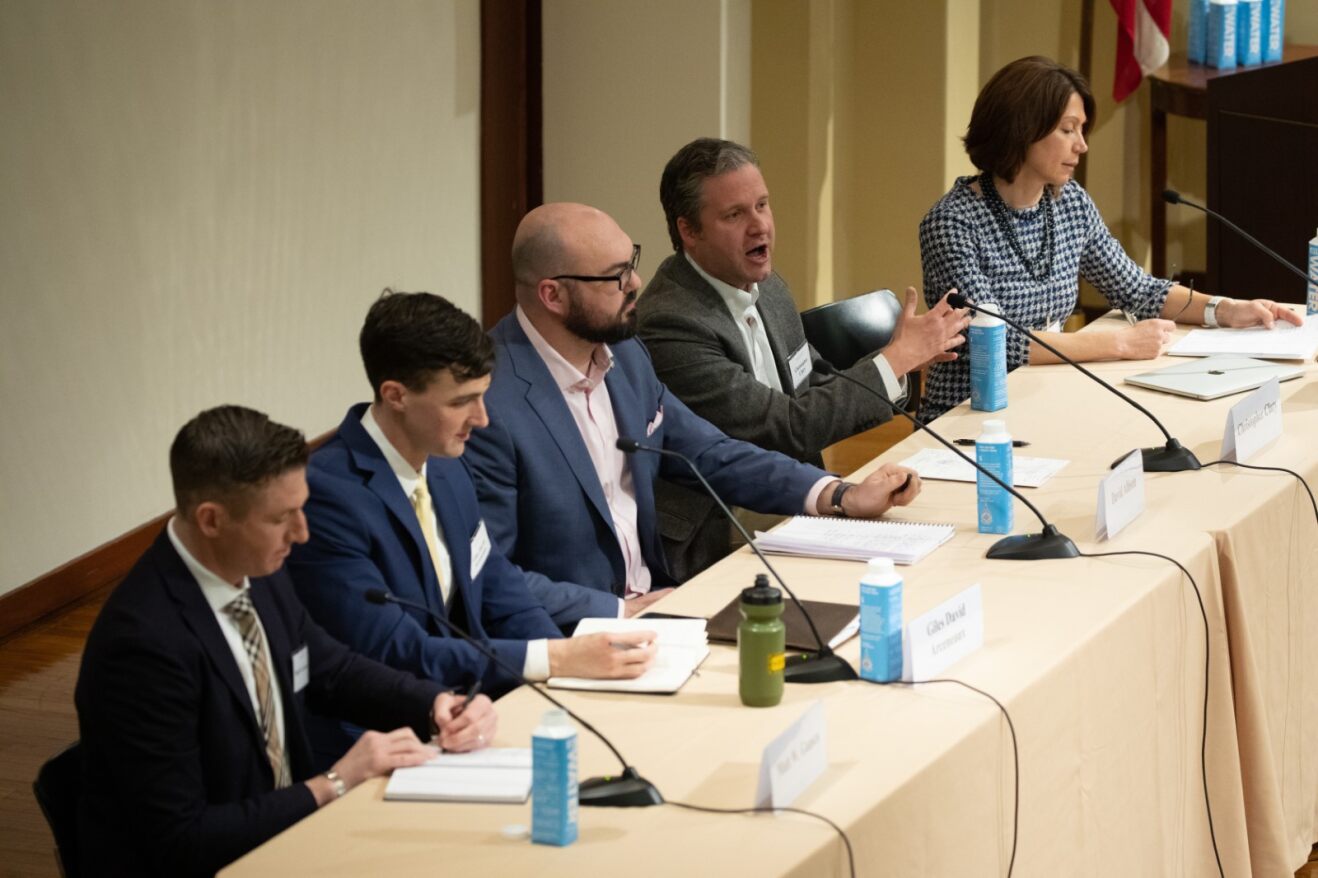On March 28, 2023, the American Academy of Arts and Sciences hosted a panel event celebrating the January 2023 launch of The Fragile Balance of Terror: Deterrence in the Nuclear Age, an open-access volume edited by Vipin Narang and Scott Sagan and produced under the Academy’s Meeting the Challenges of the New Nuclear Age project. The hybrid event was co-sponsored by The Project on Managing the Atom at Harvard’s Belfer Center for Science and International Affairs and provided the in-person and virtual audiences with opportunities to hear from contributing authors.
Drawing on the insights of nuclear experts and policy experts, The Fragile Balance of Terror offers extensive analysis of concerns arising from the increasing number of states armed with nuclear weapons. At the event, authors from the volume outlined and expanded upon their chapters to shed light upon the destabilizing factors contributing to the current nuclear landscape. These factors include unpredictable leadership, domestic unrest, volatile states, and rapid technological advancements.
FIRST PANEL
The first panel, moderated by Dr. Francesca Giovannini (Harvard Kennedy School), began with Heather Williams (Center for International Strategic Studies) expanding upon Thermonuclear Twitter?, the third chapter of Fragile Balance, which she co-authored with Dr. Vipin Narang (US Department of Defense). Williams explained that social media has fundamentally changed citizens’ relationship with organizations and governments. By analyzing social media interactions on multiple platforms, Williams and Narang evaluated the impact of social media communications in ongoing and discrete crises. When asked whether social media is helpful or hurtful in these situations, Williams opined “it depends” before explaining that while social media can generate and exacerbate misinformation, it can also deescalate conflicts by rapidly disseminating accurate information.
Dr. Heather Williams (CSIS) shares the key findings and policy implications from her co-authored chapter with Vipin Narang (absent) in The Fragile Balance of Terror, titled “Thermonuclear Twitter?” Also pictured (from left to right): Dr. Doreen Horschig (CSIS), Dr. Nicholas Miller (Dartmouth), and Dr. Francesca Giovannini (Harvard).
Williams asked the audience to consider the extent to which governments should regulate social media and direct messaging to limit disinformation in crisis scenarios, and whether governments should create information-sharing agreements to share factual information in crises.
Responding to Williams’ presentation and drawing upon her fieldwork in Russia, Dr. Nicole Grajewski invited attendees to think about the ways in which state-run media accounts in authoritarian countries might impact public narratives on nuclear issues and amplify the fog of war. She added that encrypted messaging platforms like Telegram can facilitate the spread of information that disrupts and subverts official state accounts, but they can also hasten the spread of state-driven information. She cautioned social media users to be aware that western platforms like Twitter can similarly amplify state-driven narratives originating domestically and abroad.
Dr. Nicholas L. Miller (Dartmouth), the next presenter, presented the findings of his chapter, “The Limits of Nuclear Learning in the New Nuclear Age,” which he co-authored with Dr. Mark S. Bell. Nuclear learning, Miller explained, is the process by which nuclear-armed states learn to maintain nuclear weapons security, deescalate crises, accept mutual vulnerability, and manage their arsenals. The nuclear learning theory optimistically argues that, over time, nuclear states will learn that nuclear weapons should be used only as a threat to deter invasion. Miller outlined obstacles to nuclear learning, including multiple nuclear rivalries, technological changes making first-use postures more feasible, the ambiguity of taking away the “right” lessons from a crisis, leaders’ susceptibility to biases, and the secrecy surrounding nuclear programs.
Accounting for these challenges to the model, Miller concluded that nuclear learning does not appear to explain the behavior of all modern nuclear states and that nuclear states can instead demonstrate the opposite trajectory of nuclear learning.
Dr. Doreen Horschig responded to Miller’s presentation by focusing on areas of improvement to surpass the obstacles of nuclear learning. Noting that inherent optimism offers a false promise in the new nuclear era, Horschig advocated for new approaches to nuclear decision making. This approach advocates attempting to understand adversaries’ perceptions of themselves rather than drawing on external perspectives. Horschig emphasized that nuclear experts should capitalize on new voices entering the field to foster creative thinking and shared decision making.
SECOND PANEL
Dr. Mariana Budjeryn (Harvard Belfer Center) moderated the second panel, in which Professor Christopher Clary (SUNY Albany) summarized his chapter, “Survivability in the New Era of Counterforce.” The chapter explains that it has historically taken nuclear-armed states a few years to develop deliverable weapons, and it takes states nearly two decades to develop highly mobilized second-strike capabilities. During this period of early nuclear development, according to Clary, deterrence has historically remained steadfast among adversaries, even those with weak second-strike abilities. Using the case of India and Pakistan during his presentation, Clary noted that the chance of India employing a disarming strike against Pakistan is unlikely despite heightened tensions in the region. One reason for the unlikeliness of such strikes is that it is difficult to accurately identify the nuclear weapons and storage facilities of our adversaries in satellite images. Though satellite imaging technology has become fairly accurate, the technology used to analyze satellite images cannot accurately predict which missiles are real and which are decoys. Likewise, it cannot always accurately identify which vehicles are housing and transporting missiles, and which ones are carrying civilian passengers and cargo. The likelihood of a nuclear conflict, even in high-tension regions, is therefore currently low, because states’ confidence in first strike capabilities (which rely on satellite images) is low. Dr. David Allison challenged this perspective, highlighting the potential for significant advancements in AI technology to improve identification of adversaries’ arsenals in surveillance images, and questioning the rationality and risk aversion of nuclear-armed state leaders.
Next, Professor Giles David Arceneaux spoke on his chapter, “The Fulcrum of Fragility: Command and Control in Regional Nuclear Powers,” which was co-authored with Professor Peter D. Feaver. In his presentation, Arceneaux described the operational aspects of managing and deploying nuclear weapons, emphasizing the significance of command and control in strengthening deterrence. He highlighted the "always never dilemma," where nuclear states must maintain preparedness while guaranteeing non-use without authorization, and outlined the differing command and control frameworks that states employ to respond to this dilemma. According to Arceneaux, the conditional control strategy, in which states prepare themselves to respond with nuclear force in the early stages of a crisis, raises serious concerns about modern strategic stability, particularly if Western leaders interpret North Korea's escalatory nuclear posture as preparing for a first strike.
Lieutenant Colonel Matt Guasco responded to Professor Arceneaux's presentation by emphasizing the importance of promoting confidence building, transparency, and assertive control measures in the face of increasing risks posed by new nuclear powers, cybersecurity, and artificial intelligence. Guasco stressed the significance of strategic communication, transparency, and coordination among allies to prevent nuclear conflict and hold bad actors accountable. He noted that these views are his own and do not represent the perspective of the U.S. Air Force.
ROUNDTABLE
Finally, a roundtable discussion moderated by Giovannini and joined by Professor Rebecca David Gibbons, Dr. Emma Belcher, Professor Matthew Bunn, and Professor Robert Legvold reflected on how Russia’s war in Ukraine may change the future nuclear deterrence landscape. Gibbons started the conversation by highlighting the increased public interest in nuclear issues since the war’s outset and the resulting diversity of public opinions surrounding nuclear weapons in global public discourse. Belcher agreed with Gibbons’ analysis and emphasized the unique challenges associated with dealing with nuclear-armed autocrats. Bunn added that in light of Putin’s leadership and its escalatory effect among existing great power conflicts, leaders must rethink old nuclear deterrence policies and postures. Legvold agreed with the other panelists’ observations about the complexities of the situation, acknowledging shifting public attitudes and the importance of understanding the shifting “red lines” not only of Russia, but also of the U.S., NATO, China, and other global powers.
Belcher posited that the Biden administration's measured response to Putin’s New Start withdrawal and threatening rhetoric has been effective at not further escalating the conflict. Gibbons commented on the U.S. and Europe’s frustration with much of the Global South’s lack of explicit support toward Ukraine. Legvold emphasized the importance of comprehensive security, avoiding conventional and nuclear crises, and finding new strategies and opportunities for diplomatic communication as we move forward in the coming decades. The roundtable discussion highlighted the need for adaptation and new approaches toward addressing nuclear risks, leveraging diverse perspectives, and working toward more secure deterrence frameworks.

